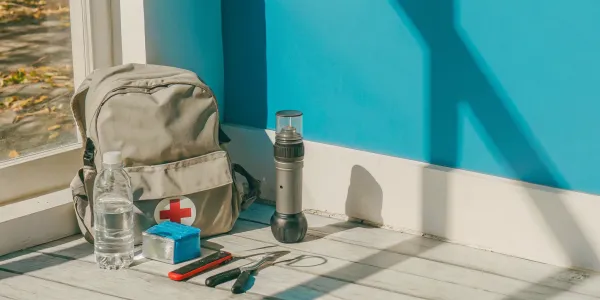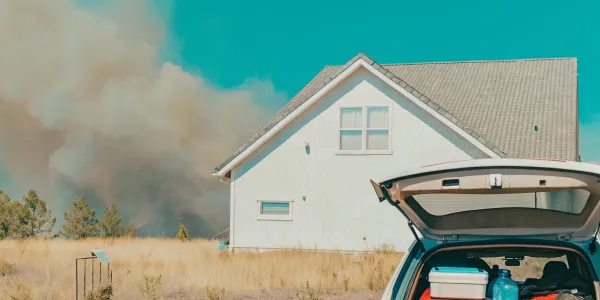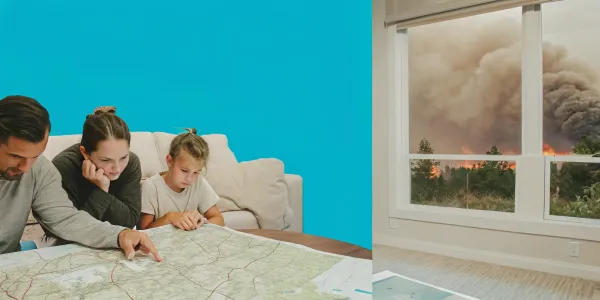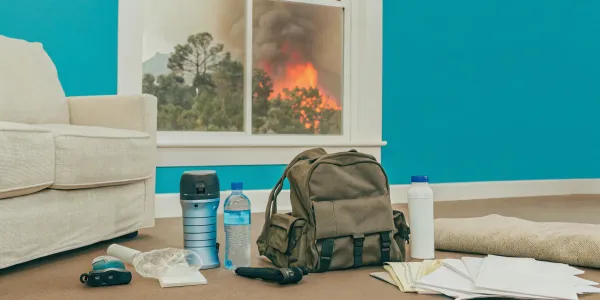What Should Be in Your Wildfire Car Emergency Kit?
Get a clear answer to what should be in a car emergency kit for wildfires. See the essential supplies, expert tips, and steps to keep your family safe.
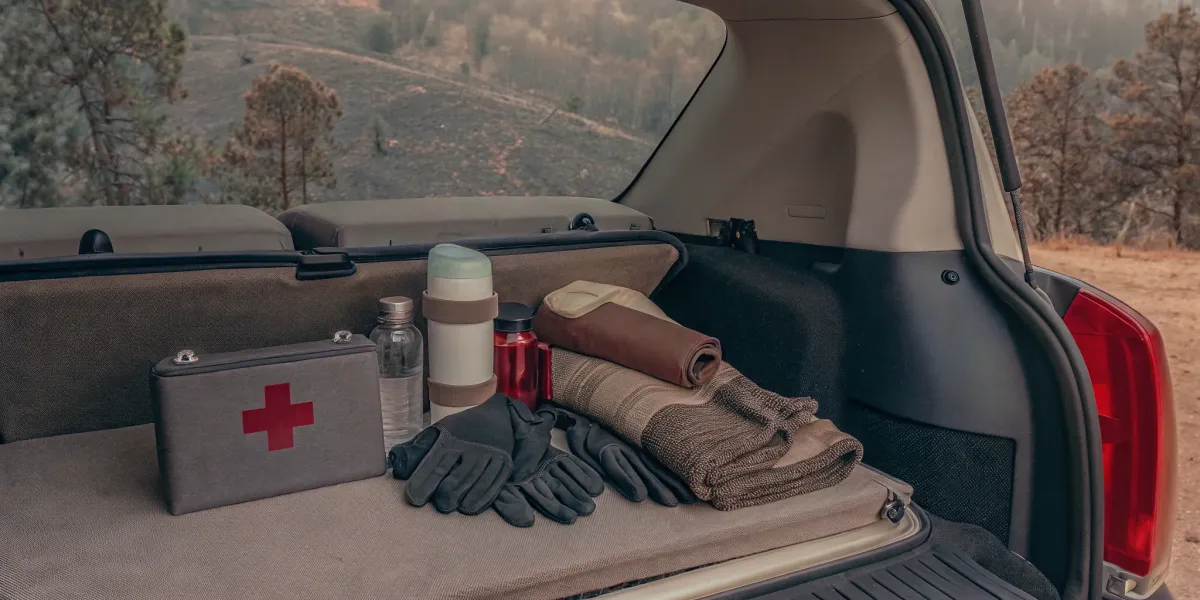
Living in a wildfire-prone area can feel like a constant state of alert, especially with the added stress of the unpredictable insurance market. It’s easy to feel powerless. But there are tangible actions you can take to reclaim a sense of control and protect your family. One of the most effective is preparing a dedicated car emergency kit. This go-bag is your assurance that you can leave at a moment’s notice with everything you need to be self-sufficient for at least 72 hours. It’s a fundamental piece of a complete Wildfire Action Plan. This article provides a definitive checklist that answers the crucial question: what should be in a car emergency kit for wildfires? We’ll help you build a kit that moves you from worry to readiness.
Key Takeaways
- Build Your Kit Before the Warning: An evacuation order means it's time to go, not pack. A well-stocked car kit with essentials like water, food, medications, and N95 masks removes the panic and allows for a safe, immediate departure.
- Maintain Your Kit for True Readiness: A go-bag is not a one-time project. Set a six-month reminder to refresh expired food and water, update medications, check batteries, and tailor supplies to your family’s current needs—including pets.
- Prep Your Vehicle for a Safe Exit: Your car is your lifeline, not just a container for your kit. Adopt the half-tank rule for fuel, regularly check your tires and battery, and keep your kit stored in the vehicle so you’re always prepared to leave without delay.
Why a Car Emergency Kit Is Non-Negotiable for Wildfire Season
When a wildfire threatens your community, the time for preparation is over. Evacuation orders can come with little warning, leaving you with only minutes to get your family and pets to safety. In that high-stress moment, trying to decide what to pack is the last thing you should be worried about. This is why having a dedicated emergency kit in your car isn’t just a good idea—it’s a critical part of your family’s safety plan. A well-stocked car kit, or "go-bag," removes the guesswork and panic from the equation, allowing you to focus on the one thing that matters: a safe and immediate departure.
The Reality of a Wildfire Evacuation
It’s easy to imagine you’ll have time to gather essentials, but the reality of a modern wildfire evacuation is speed. Fire officials are clear: if you are told to evacuate, you must leave right away. In fast-moving fires, there may not be time for door-to-door warnings, and alerts will come through text messages or public announcements. Hesitation not only puts you and your family at greater risk but can also create traffic jams that block emergency vehicles from getting into the area. Your preparedness directly impacts their ability to protect your community. Waiting to see how close the flames get is a dangerous gamble you can’t afford to take.
How a Go-Bag for Your Car Gives You Control
A car emergency kit is your tool for taking back control in a chaotic situation. CAL FIRE refers to this as a “Go Bag”—a kit you prepare long before a wildfire strikes so it’s ready to grab at a moment’s notice. Having one packed and stored in your vehicle means you’ve already made the important decisions. You won’t be scrambling to find flashlights, first-aid supplies, or important documents. This kit ensures you can care for yourself and your family if you’re displaced from your home for an extended period. It’s a fundamental piece of a complete Wildfire Action Plan, giving you the confidence to act decisively when every second counts.
Your Wildfire Car Kit Checklist: The Essentials
When an evacuation order comes, you won’t have time to think, let alone pack. Having a dedicated emergency kit in your car is one of the most important steps you can take to protect your family. This isn’t just about having a few supplies; it’s about having the right supplies, ready to go at a moment’s notice. Think of it as your lifeline on wheels. We’ve broken down the absolute must-haves for your wildfire car kit, based on recommendations from emergency response experts. Use this checklist to build your kit so you can leave with confidence, knowing you have what you need to stay safe.
Water and Non-Perishable Food
During an evacuation, you could be stuck in traffic for hours or find that stores and restaurants are closed. Your kit should have enough food and water to last each person for at least three days. CAL FIRE recommends packing one gallon of water per person, per day. For food, choose items that don’t need refrigeration or cooking, like protein bars, dried fruit, nuts, and canned goods. If you pack canned food, don’t forget a manual can opener. It’s also a good idea to include some comfort foods, especially if you have children—a small treat can make a stressful situation a little more bearable.
First-Aid Kit and Medications
Minor injuries can happen during a hectic evacuation, so a well-stocked first-aid kit is critical. You can buy a pre-made kit or build your own. According to the American Red Cross, it should include essentials like sterile bandages, antiseptic wipes, pain relievers, gauze pads, adhesive tape, scissors, and non-latex gloves. Beyond a standard kit, be sure to pack a 7- to 10-day supply of any prescription medications for your family members and pets. Include a list of medications, dosages, and allergies. If you wear glasses or contacts, pack an extra pair.
Copies of Important Documents
If your home is damaged or destroyed, proving your identity and ownership of your property will be essential for recovery and insurance claims. Keep copies of your most important documents in a waterproof and fire-resistant bag. This includes birth certificates, passports, driver’s licenses, social security cards, and insurance policies. You should also have copies of property deeds, vehicle titles, and recent bank account statements. In addition to physical copies, save digital versions on a password-protected USB drive. This small step can save you from enormous headaches later on.
Multi-Tool and Other Basic Equipment
A quality multi-tool can be incredibly useful in a variety of situations, from making small repairs to opening packages. Your car kit should also include some basic equipment to handle common roadside issues. Pack a flashlight (an LED model is best for battery life) and plenty of extra batteries. Jumper cables, a tire pressure gauge, and basic tools like a wrench and screwdrivers are also smart additions. A roll of duct tape and a pair of sturdy work gloves don’t take up much space but can be invaluable when you need them.
Protective Clothing and Gear
You might have to evacuate in the middle of the night with only the clothes on your back. Your car kit should contain a full change of clothes for each family member. Focus on durable, comfortable items you can layer. Wildfire safety experts recommend long-sleeved shirts and long pants made from natural fibers like cotton or wool, as they are less likely to melt than synthetics. Everyone should have a pair of sturdy, closed-toe shoes or boots to protect their feet from hot ground and sharp debris. Also, pack a warm blanket for each person.
N95 Masks to Protect Your Lungs
Wildfire smoke is a toxic mix of gases and fine particles that can cause serious respiratory problems. A simple cloth mask or bandana won’t protect you. Your kit must include N95 or P100 respirator masks to filter out these dangerous particles. Ready.gov stresses the importance of these masks for anyone in a wildfire-prone area. Make sure you have enough for everyone in your household and that you know how to wear them correctly for a tight seal. This is not an item to skip—protecting your lungs from smoke is just as important as protecting your body from flames.
Stay Safe and Connected on the Road
When an evacuation order comes, the road is your lifeline. But in the chaos of a wildfire, the modern conveniences we rely on—like cell service and GPS—are often the first things to fail. Cell towers can be damaged or overloaded, leaving you without a way to call for help or check for updates. Getting stuck with a dead battery or a flat tire on a smoke-filled road is a scenario no one wants to face. This is why your car kit must include tools to keep you informed, connected, and mobile, even when the power grid is down. Preparing for these challenges ahead of time gives you a critical advantage, allowing you to move safely and confidently when every second counts. Your goal is to be self-sufficient, equipped to handle common roadside issues and stay aware of changing conditions without relying on a network that might not be there. A complete Wildfire Action Plan includes these vehicle preparations so you're ready for anything.
Offline Maps and Navigation
Your phone’s GPS is great for daily commutes, but it’s a risky bet during a wildfire. When cell service disappears, so does your map. Before the fire season starts, download offline maps of your entire region onto your phone. More importantly, keep physical, paper maps in your car as a foolproof backup. Familiarize yourself with your surroundings and identify at least two different evacuation routes from your home, just as emergency officials recommend. If one road is blocked by fire or traffic, you need a Plan B ready to go without having to think. Knowing your way out is a fundamental part of a solid evacuation plan.
Communication Tools (When Cell Service Fails)
When a wildfire spreads, cell networks often become congested or fail completely, cutting you off from vital information. Don’t get left in the dark. An emergency hand-crank or battery-powered radio is an essential tool for your car kit. It allows you to receive official alerts from NOAA Weather Radio and local emergency broadcasters, keeping you updated on fire movement, road closures, and shelter locations. This simple device ensures you have a reliable way to stay informed about the situation, even when your phone has no signal. It’s a low-tech solution for a high-stakes problem.
Power Banks and Chargers
Your smartphone is your link to emergency alerts, maps, and family—but only if it has power. A dead phone during an evacuation is a serious liability. Pack at least one fully charged portable power bank in your car kit, along with the necessary charging cables for your devices. A reliable car charger is also a must-have. This simple step ensures you can keep your phone and other small electronics, like a rechargeable flashlight, running when you need them most. Think of it as your personal power grid, ready to go when the main one fails.
Essential Car Safety Tools
A simple car problem can become a life-threatening situation during a wildfire evacuation. Being stranded on the side of the road with smoke reducing visibility is incredibly dangerous. Your kit should include basic tools to handle common issues. Pack a set of jumper cables for a dead battery, a bright flashlight with extra batteries for visibility, and road flares or reflective triangles to warn other drivers if you have to pull over. These emergency car kit items don't take up much space but can make all the difference in getting you and your family to safety.
Customize Your Kit for Your Household
A generic, one-size-fits-all emergency kit won’t cut it when your family’s safety is on the line. Every household is unique, and your car kit must reflect your specific circumstances. Think about the daily needs of everyone under your roof—including infants, children, elderly relatives, and those with medical conditions. A well-customized kit means you aren’t scrambling for diapers, specific medications, or a favorite comfort toy during an already stressful evacuation. Taking the time now to personalize your supplies ensures everyone’s core needs are met, providing security and a small sense of normalcy when you need it most.
What Your Family Needs
Your goal is to pack enough essential supplies to last each person for at least three days. For families with infants, this means having ready-to-use formula, bottles, diapers, and wipes. If you have young children, include a few small, non-electronic activities like a book or card game to keep them occupied. For older adults or family members with health issues, pack a complete list of their medications, dosages, and any necessary medical equipment like hearing aids with extra batteries. Creating a complete emergency supply kit tailored to these individual needs is one of the most important steps you can take to prepare for an evacuation order.
Don't Forget Your Pets
Your pets are part of the family, and they depend on you entirely during an emergency. Your car kit must include a dedicated go-bag for them, too. Pack a sturdy carrier for each animal, a leash and collar with up-to-date ID tags, and at least a three-day supply of their food and water. Don’t forget bowls, any medications they take, and a pet first-aid kit. For cats, include a small litter box and litter. A favorite toy or blanket can also reduce their stress significantly. Having a complete pet emergency plan ready means you won’t have to make an impossible choice or lose precious time when you need to leave quickly.
Adjust for the Season
Wildfire season can stretch from the hot, dry months of summer into the cooler, unpredictable weather of fall and winter. Your car kit shouldn't be static; it needs to adapt to the time of year. In the summer, be sure to have extra water, sunscreen, and lightweight, long-sleeved shirts for sun protection. As the seasons change, swap in or add warmer items. Pack thermal blankets, extra socks, rain ponchos, and warm layers for everyone in the family. An evacuation can happen at any time of day or night, and you may find yourself without power or heat. A few simple seasonal adjustments can make a world of difference in your comfort and safety.
Sanitation and Personal Comfort Items
Maintaining hygiene is crucial for health and morale during an evacuation. Pack a separate toiletry bag with essential personal hygiene items for each family member. This should include toothbrushes, toothpaste, soap, deodorant, and a comb or brush. Moist towelettes or baby wipes are incredibly versatile for quick clean-ups when water is scarce. Also include any necessary feminine hygiene products and contact lens solution. These small comforts are easy to overlook but provide a sense of dignity and routine in a chaotic situation, helping your family feel more grounded and secure while you’re away from home.
How to Pack and Store Your Kit Effectively
Having the right supplies is only half the battle. How you pack and store your car kit determines how useful it will be when seconds count. A disorganized, poorly protected kit can fail you when you need it most. The goal is to create a system that’s durable, easy to access, and simple to manage. Think of it as setting up your future self for success during a high-stress evacuation. By taking a few extra steps now, you ensure your food, water, documents, and tools are ready to go the moment you get an evacuation warning. This isn't just about storage; it's about creating a reliable lifeline.
Protect Supplies from Extreme Temperatures
Your car is not a climate-controlled environment. On a hot day, the interior can reach temperatures that damage electronics, melt medications, and spoil certain foods. In the winter, freezing temperatures can cause canned goods and water bottles to burst. To protect your supplies, Cal OES recommends storing items in airtight plastic bags inside a larger, durable container like a plastic bin with a secure lid. This creates a buffer against temperature swings and keeps everything in one place. Consider using an insulated cooler for water and other sensitive items to provide an extra layer of protection from the heat.
Organize for Grab-and-Go Access
When an evacuation order is issued, you won’t have time to search for scattered items. Your kit needs to be ready for immediate action. The best practice is to store everything in one or two easy-to-carry containers in your trunk or cargo area. Some experts even suggest preparing for a wildfire evacuation by parking your car in the driveway facing outwards, fully loaded and ready to go during peak fire season. This simple habit can save you critical minutes. Group similar items together within your kit—for example, put all first-aid supplies in one labeled pouch and all communication tools in another. This makes it easy to find exactly what you need without unpacking everything on the side of the road.
Keep Your Gear Dry
Moisture is the enemy of preparedness. A leaky water bottle, condensation, or an unexpected rainstorm can ruin important documents, short-circuit electronics, and make clothing useless. The solution is simple but effective: store items in airtight plastic bags. This is especially critical for your copies of important documents, spare batteries, chargers, and any medications. Double-bag anything that is particularly vulnerable. This small step ensures that your essential gear remains dry and functional, no matter the conditions you face during an evacuation. It’s a low-cost way to protect your investment in safety.
Pack Smart to Save Space
Your car has limited space, especially when you’re also packing personal items and potentially pets. Packing your emergency kit efficiently is key. Use sturdy, stackable plastic bins or duffel bags that can be compressed to fit into tight spaces. Rolling clothes and towels instead of folding them can save a surprising amount of room. Look for multi-use items to reduce clutter—a single multi-tool can replace a whole box of individual tools. A well-organized kit not only saves space but is also easier to carry if you need to leave your vehicle behind. Your entire Wildfire Action Plan should be built around efficiency, and your car kit is no exception.
Prep Your Vehicle for Evacuation
Your car is more than just transportation during a wildfire—it’s your lifeline. When an evacuation order comes, you won’t have time to wonder if your car will start or if you have enough gas. A vehicle that’s ready to go at a moment’s notice is a core part of a solid emergency plan. This means thinking beyond just having a go-bag in the trunk. It involves regular maintenance, keeping essential tools on hand, and adopting a few key habits that can make all the difference when seconds count. Preparing your car is an actionable step you can take right now to give yourself peace of mind and a critical head start.
It's about taking control in a situation that can feel chaotic, ensuring that when you need to leave, your vehicle is the one thing you don't have to worry about. This preparation isn't about complex mechanical work; it's about simple, consistent checks and having the right supplies ready before you need them. From the fuel in your tank to the air in your tires, every detail contributes to a safer, smoother evacuation. Think about the potential challenges on the road: heavy traffic, road closures, poor visibility from smoke, and the possibility of debris. A well-maintained car with the right emergency supplies can help you handle these obstacles safely, keeping you and your family moving toward safety instead of being stranded on the roadside.
Basic Car Maintenance Supplies
Think of this as a first-aid kit for your car. A small, dedicated kit with basic maintenance supplies can help you handle minor issues on the road that could otherwise leave you stranded. You don’t need to be a mechanic to pack one. Include items like a tire pressure gauge, jumper cables, a portable tire inflator, and basic fluids like a quart of oil and coolant. The California Governor's Office of Emergency Services suggests you build an emergency kit by storing items in airtight plastic bags inside an easy-to-carry container. This simple preparation ensures you’re not caught off guard by a dead battery or a low tire during a stressful evacuation.
The "Half-Tank" Rule
This is one of the easiest and most important habits to adopt during fire season. Always keep your car’s gas tank at least half full. Evacuation orders can be issued with little warning, and you may face heavy traffic and long drives to safety. Gas stations can lose power or run out of fuel during a widespread emergency, so you can’t rely on being able to fill up on your way out of town. Making the half-tank rule a non-negotiable part of your routine ensures you have the fuel to prepare your car for evacuation without a moment’s delay.
Must-Have Tools for Your Car
Beyond basic maintenance, a few essential tools can help you manage unexpected situations. Your car kit should be equipped to handle more than just vehicle trouble. The American Red Cross recommends an emergency car kit that includes jumper cables, a flashlight with extra batteries, a hand-crank emergency radio, and a first-aid kit. These items are crucial for staying safe, informed, and able to help yourself or others if you get stuck on the road. Having these tools organized and accessible means you’re prepared for a wider range of challenges during an evacuation.
Check Your Tires and Battery
Your car’s reliability starts with its most common points of failure: the tires and the battery. A dead battery or a flat tire can stop an evacuation in its tracks. Before fire season begins, have your battery tested to ensure it holds a charge. Regularly inspect your tires for proper inflation and sufficient tread. If your tires are worn, replace them. Having good tires isn't just about preventing a flat; it's about ensuring your vehicle has the traction it needs on potentially debris-covered roads. These simple checks are a critical investment in your safety.
Keep Your Kit Ready to Go
Assembling a car emergency kit is a fantastic first step, but it’s not a one-and-done task. A go-bag is a living tool that needs regular maintenance to be effective when you need it most. The last thing you want during a stressful evacuation is to discover your flashlight batteries are dead or your water supply has leaked. Creating a simple maintenance routine is a core part of a successful Wildfire Action Plan. It’s how you turn a box of supplies into a reliable lifeline, ensuring your preparation pays off when every second counts. Think of it as protecting your investment in your family’s safety.
Set a Six-Month Check-Up Reminder
This simple habit is one of the most important. The National Safety Council recommends that every vehicle’s emergency kit “should be checked every six months, and expired items should be replaced regularly.” The easiest way to follow this advice is to put it on autopilot. Pull out your phone right now and set a recurring calendar reminder for every six months—perhaps in the spring and fall when you’re already thinking about seasonal home maintenance. During your check-up, inspect expiration dates on food, water, medications, and batteries. Test your flashlight and emergency radio. This small, proactive step ensures your kit is always ready for action.
Know When to Refresh Your Supplies
Your car is not a climate-controlled storage unit. Extreme heat and cold can take a toll on your supplies over time. To protect them, Cal OES suggests you “store items in airtight plastic bags and put your entire disaster supplies kit in one or two easy-to-carry containers.” This simple step helps prevent leaks, keeps moisture and pests out, and preserves the quality of your gear. When you perform your six-month check, be prepared to replace items. While canned goods are durable, things like granola bars, bottled water, and certain medications have shorter shelf lives. It’s a quick refresh that keeps your kit dependable.
Choose the Best Spot in Your Car
Where you store your kit can make a real difference. You need it to be easily accessible in an emergency but not in the way of your daily life. For most people, the trunk or a rear cargo area is the ideal spot. The goal is to make your departure as smooth and fast as possible. During high-risk fire seasons, some officials even recommend you “park your car in the driveway, facing outwards, loaded and ready.” Adopting this mindset is key. By having your kit packed and your vehicle positioned for a quick exit, you eliminate last-minute scrambling and reduce stress, freeing you up to focus on getting your family out safely.
Swap Items Out Seasonally
While your core supplies will stay the same year-round, making small seasonal adjustments can make your kit even more effective. As you head into the cooler months, consider adding extra blankets, hand warmers, or a rain poncho. In the summer, you might want to pack extra water, sunscreen, or a battery-operated fan. This is also a perfect time to do a quick vehicle check. As experts advise, always try to keep your gas tank at least half full in case of evacuation orders or power outages, and make sure your tires are properly inflated and have enough tread.
Common Go-Bag Mistakes (and How to Avoid Them)
Building a car emergency kit is a huge step toward protecting your family. But a few common missteps can undermine all your hard work. In a high-stress evacuation, you need a kit that’s reliable, complete, and ready to go at a moment’s notice. It’s not just about having the supplies; it’s about ensuring they’re the right supplies, that they work, and that they fit into a larger safety strategy.
Think of it as quality control for your peace of mind. Avoiding these common mistakes ensures that when the time comes, your go-bag is an asset, not a source of additional stress. Let’s walk through the most frequent errors homeowners make and cover the simple, practical ways you can avoid them. This way, you can be confident that your preparation will truly count when it matters most.
Forgetting Critical Supplies
It’s easy to pack the basics like water and snacks but forget the items that make a real difference in an emergency. Think about things like a physical map for when GPS fails, a hand-crank radio for updates, or cash in small bills for when credit card systems are down. To make sure nothing gets missed, use a detailed checklist. Once you have your items, Cal OES advises you to "store items in airtight plastic bags and put your entire disaster supplies kit in one or two easy-to-carry containers." This protects your gear from water damage and keeps everything organized and accessible when every second counts.
The "Set It and Forget It" Syndrome
Your go-bag isn't a time capsule. It’s a living tool that needs regular maintenance. Food expires, batteries die, medications need updating, and your kids’ clothing needs change. A common mistake is packing a kit and then forgetting about it for years. You should also extend this mindset to your vehicle itself. As experts at Your Tahoe Guide recommend, you should always "keep your gas tank full in case of evacuation or power outages." Set a reminder on your calendar to check your kit every six months—once in the spring and once in the fall—to refresh supplies and ensure everything is in working order.
Not Having a Complete Plan
A go-bag is a critical tool, but it’s only one piece of your overall safety puzzle. Having a kit without an evacuation plan is like having a key with no idea which door it opens. You need to know your primary and secondary evacuation routes, have a designated meeting place for your family, and understand how you’ll communicate if cell service is down. As Ready.gov points out, you also need a plan for scenarios where you can't leave immediately: "If you are not ordered to evacuate but smoky conditions exist, stay inside in a safe location." Your kit supports your plan, so take the time to build a complete Wildfire Action Plan for your household.
Underestimating Wildfire Smoke
Many people focus on the threat of flames but overlook the severe danger of thick wildfire smoke, which can quickly overwhelm you and your vehicle. Smoke drastically reduces visibility and contains toxic particles that are hazardous to breathe. Your car is not airtight. According to Fire Safe Marin, you should be prepared to "roll up windows and close air vents." Driving through dense smoke can also cause your engine to stall. This is why your kit must include N95 masks for everyone in your household and you should know how to set your car’s air system to recirculate. Don’t wait until the air is thick with ash to figure it out.
Build Your Wildfire Car Kit Today
Getting started with a car emergency kit can feel like a huge project, but it doesn't have to be. The most important thing is to simply begin. Taking this one step gives you a tangible tool for your safety and a bit of control in a situation that often feels uncontrollable. Think of it as the physical part of your larger preparedness strategy, a crucial piece that works alongside your evacuation routes and communication plans. A well-stocked kit means you can focus on getting to safety, knowing you have what you need for the first 72 hours.
We’ve broken the process down into four straightforward steps. You can tackle one a day or all at once over a weekend. The goal is to move from planning to doing. By following these steps, you’ll build a comprehensive kit that’s ready when you need it most. This isn't just about checking a box; it's about creating a resource that supports your family's well-being during a crisis. Your complete Wildfire Action Plan gives you the roadmap, and this kit is the essential gear for the journey. Let’s get it done.
Step 1: Gather the Absolute Basics
First things first, let's cover the absolute must-haves. Don't worry about getting everything at once; start with the items that will sustain you. According to CAL FIRE, your kit should hold enough supplies for you to be away from home for at least three days. This means packing a three-day supply of non-perishable food for each person in your household. Think protein bars, canned goods with a pop-top, and dried fruit. Just as critical is water—plan for one gallon of water per person, per day. For a three-day kit, that’s three gallons for each person. These are the foundational items of your emergency supply kit, so gather them first.
Step 2: Add Safety and Communication Gear
Once you have food and water covered, it’s time to add gear that will keep you safe and informed. A well-stocked first-aid kit is essential for treating minor injuries on the go. You’ll also need a reliable way to get information when cell towers and power lines are down. An emergency crank or battery-powered radio is your best bet for receiving official alerts. The American Red Cross also highlights the importance of a flashlight with extra batteries for navigating in the dark or signaling for help. These essential items form the next layer of your kit, giving you the tools to handle unexpected challenges on the road.
Step 3: Schedule Your First Kit Check-Up
Building your kit is a fantastic first step, but it’s not a one-and-done task. Your supplies need to be maintained to be effective. The National Safety Council recommends you check your kit every six months. Set a recurring reminder on your phone right now for six months from today. During your check-up, you’ll want to swap out any expired food, water, or medications. Test your flashlight and radio, and replace the batteries even if they still work. This simple habit ensures that when an emergency strikes, your kit is genuinely ready to go. It’s a small time investment that pays off in reliability and peace of mind.
Step 4: Pack It and Place It in Your Vehicle
Now that you’ve gathered your supplies, it’s time to pack them for grab-and-go access. Store items in airtight plastic bags to protect them from moisture, and then place everything into one or two easy-to-carry containers like a duffel bag or plastic bin. The final, most important step is to put the kit in your car immediately. Don’t leave it in the garage or by the front door. When an evacuation order comes, you won’t have time to think. As you place the kit in your trunk, get into the habit of parking your car in the driveway facing the street. This simple practice can save you critical minutes when it’s time to evacuate.
Related Articles
- Wildfire Action Plan | Comprehensive Wildfire Preparedness & Emergency Planning
- Wildfire Action Plan | Comprehensive Wildfire Preparedness & Emergency Planning
- Wildfire Action Plan | Comprehensive Wildfire Preparedness & Emergency Planning
- Wildfire Action Plan | Comprehensive Wildfire Preparedness & Emergency Planning
- Wildfire Action Plan | Comprehensive Wildfire Preparedness & Emergency Planning
Frequently Asked Questions
This checklist is long and feels overwhelming. What are the absolute first things I should pack? I get it, the list can look intimidating. Don't try to do it all at once. Focus on the "Big Three" first: water, food, and a first-aid kit. Aim for one gallon of water per person, per day, for three days. Grab non-perishable foods like protein bars or canned goods. Then, add a basic first-aid kit. Starting with these core items is a huge win. You can always add the other gear, like flashlights and documents, over the next few days. The goal is progress, not perfection.
I already have an emergency kit at home. Can't I just grab that one? While a home kit is great, a dedicated car kit is designed for a fast getaway. Wildfire evacuations often leave you with only minutes to leave. Having a kit already in your vehicle removes the need to search for supplies under pressure. It also includes car-specific tools like jumper cables and offline maps that you wouldn't typically keep in a home kit, ensuring you're prepared for challenges on the road.
I'm worried about leaving food and water in my car, especially during hot summers. How do I keep them from spoiling? This is a valid concern, as extreme temperatures inside a car can damage supplies. To protect them, store water and food in a sturdy, insulated cooler in your trunk. This helps moderate the temperature. For other items like batteries and medications, use airtight plastic bags inside a durable bin. When you do your six-month kit check-up, be sure to rotate the food and water to keep everything fresh.
What's the most common mistake people make with their car kits? The biggest mistake is treating it as a one-time project. People pack a great kit and then forget about it for years. By the time an emergency happens, the food has expired, the batteries are dead, and the kids' clothes are two sizes too small. Your kit is a living tool. Set a recurring six-month reminder on your phone to check and refresh your supplies. This simple habit ensures your kit is actually ready when you need it.
I have pets. What are the most important things to remember for them? Your pets depend on you completely, so their needs are a top priority. The most critical items are a sturdy carrier for each pet and at least a three-day supply of their specific food and any medications they take. Also, make sure their collar has an up-to-date ID tag. In the chaos of an evacuation, having these items ready means you won't waste precious time or risk leaving a family member behind.

